There are 45 different types of snakes in Oklahoma including Rat snakes, Blind snakes, and many more. The majority of these species aren’t harmful to humans, although 7 venomous snakes are native to Oklahoma.
The harmless species found in Oklahoma features a diverse range from Garter snakes and Hog-nosed snakes to Night snakes and Water snakes.
To help you identify the snakes of Oklahoma, we’ve put together a comprehensive list that makes for a useful herping guide. We’ve broken down this list into the different types of snakes to make it easier to navigate.
We’ll also provide details on Oklahoma’s venomous snakes to help you avoid them. Here are the 45 snakes native to Oklahoma.
Table of Contents
Common Snakes in Oklahoma
1. New Mexico Blind Snake
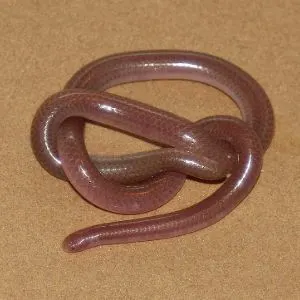
- Family: Leptotyphlopidae
- Scientific Name: Rena dissecta
- Other Names: New Mexico Thread snake
- Adult Size: 5 to 10 inches (13 to 25 cm)
- Lifespan: Various
The New Mexico Blind snake is a small species of burrowing snake that is found in the western half of Oklahoma. There are two subspecies found in Oklahoma.
The New Mexico Blind snake resides in the northwestern regions of the state, while the Plains or Texas Blind snake (Rena dulcis dulcis) is found in the southwestern part of Oklahoma.
New Mexico Blind snakes look more like worms than true snakes, with a blunt head. They are smooth and are usually reddish-brown or pinkish in color. They have lightly colored undersides, usually pink or white.
These Blind snakes prefer desert or rocky areas of Oklahoma and are primarily active at dusk and nighttime. During the day, they will shelter in loose soil under logs or rocks. New Mexico Blind snakes eat small insects, mainly ants, and termites.
2. Dekay’s Brown Snake
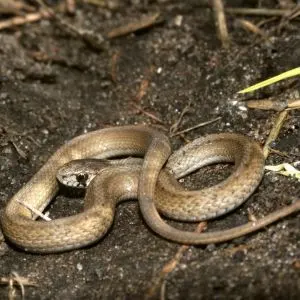
- Family: Colubridae
- Scientific Name: Storeria dekayi
- Other Names: Brown snake, Dekay’s snake
- Adult Size: 10 to 15 inches (25 to 38 cm)
- Lifespan: 7 years
Dekay’s Brown snakes are named after American zoologist James Ellsworth Dekay. These scaled colubrids are found across most of Oklahoma except for extreme western counties and the Panhandle.
They inhabit marshy or woodland areas but can also be seen in urban surroundings.
Dekay’s Brown snakes are scaled snakes that are predominantly brown or gray, with two columns of darker scales running down the length of their body. Their undersides range from brown to yellow to pink.
These snakes give birth to live young and are part of the Natricine group of snakes. They are mollusk eaters, consuming earthworms, slugs, and snails.
Their jaws are designed to easily remove snails from the safety of their shells.
3. Rough Earth Snake
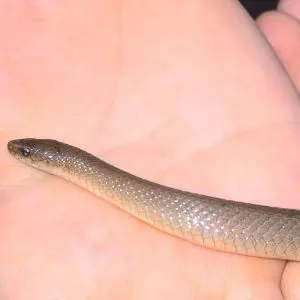
- Family: Colubridae
- Scientific Name: Haldea striatula
- Other Names: N/A
- Adult Size: 7 to 10 inches (18 to 25 cm)
- Lifespan: 7 years
Rough Earth snakes are fossorial species of scaled snake that is found in the eastern half of Oklahoma. These colubrids mainly inhabit sheltered woodlands, sometimes in woods on rocky outcrops. They keep themselves hidden underneath logs or rocks.
Rough Earth snakes are brown or gray, with tapered snouts and slightly keeled scales, and a divided anal plate. They have cream or yellow undersides.
If picked up, Rough Earth snakes can produce a foul-smelling musk as a defense mechanism.
These snakes are mollusk hunters, preying on earthworms, slugs, and snails. They burrow into the ground to catch their prey, swallowing it whole rather than using constriction.
4. Western Smooth Earth Snake
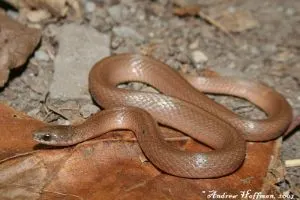
- Family: Colubridae
- Scientific Name: Virginia valeriae elegans
- Other Names: Western Earth snake
- Adult Size: 7 to 10 inches (18 to 25 cm)
- Lifespan: 7 years
Western Smooth Earth snakes are a subspecies of the Smooth Earth snake that can be seen in Oklahoma’s eastern areas, except for northeast counties. These colubrids favor woodland areas and are especially active and visible after heavy rain.
Western Smooth Earth snakes are a plain brown color with 17 rows of smooth scales. They can sometimes have faded bands running down their backs. Their undersides are white or yellowish in color and they have divided plates.
These smooth serpents are live-bearers. Western Smooth Earth snakes primarily eat mollusks and small insects with softer bodies such as spiders.
5. Common Garter Snake
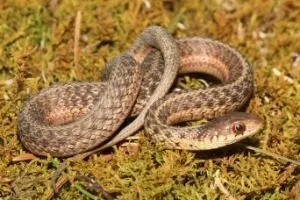
- Experience Level: Beginner to Intermediate
- Family: Colubridae
- Scientific Name: Thamnophis sirtalis
- Other Names: Garden snake, Gardener snake
- Adult Size: 18 to 48 inches (46 to 120 cm)
- Lifespan: 10 years
- Average Price Range: $15 to $45
Garter snakes are one of the most widespread species in the United States and can be kept fairly easily as pets.
In Oklahoma, the Common Garter snake can be seen in most regions apart from the southwest and the Panhandle area. They prefer woodland regions with a water body such as a pond or stream.
Common Garter snakes are vibrantly colored, with dark brown bodies and stripes ranging from red to orange or yellow. These thin snakes also have black check patterning in between their stripes. Their scales are keeled and they have a single anal plate.
Common Garter snakes can act defensively when handled, sometimes spraying musk. However, they do quickly get used to handling and will calm down.
Individuals can sometimes reach 4 feet in length. These diurnal snakes will eat amphibians, fish, worms, and small mammals.
6. Checkered Garter Snake
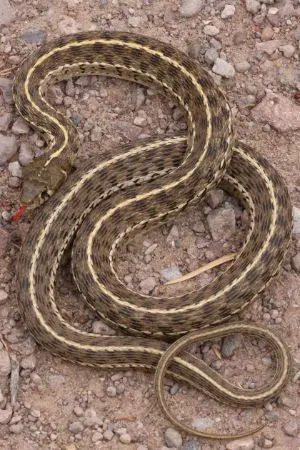
- Experience Level: Beginner to Intermediate
- Family: Colubridae
- Scientific Name: Thamnophis marcianus
- Other Names: Marcy’s Checkered Garter snake
- Adult Size: 18 to 36 inches (45 to 90 cm)
- Lifespan: 10 years
- Average Price Range: $25 to $150
Checkered Garter snakes are distinctive thin serpents named after American Army officer Randolph B. Marcy. They have green to tan bodies with noticeable black check patterning on their sides and a lightly colored stripe running down the center.
Checkered Garter snakes can be great pets and are easy to tame. Morphs are also available. In the wild, these diurnal snakes are found in scattered western parts of Oklahoma, inhabiting dry grasslands close to rivers or streams.
The main food sources for Checkered Garter snakes are amphibians and crustaceans such as crayfish. Like many Garter snakes, they are mildly venomous but pose little danger to a human being.
6. Plains Garter Snake
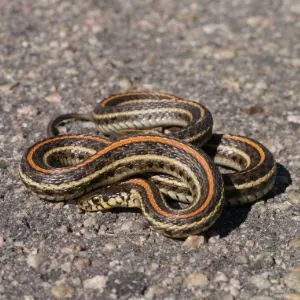
- Family: Colubridae
- Scientific Name: Thamnophis radix
- Other Names: N/A
- Adult Size: 20 to 36 inches (50 to 90 cm)
- Lifespan: 10 years
Plains Garter snakes are a type of Garter snake found throughout the Panhandle region of Oklahoma. These thin colubrids inhabit open grasslands and prairies that are close to rivers or other water sources.
These distinctive serpents have dark brown bodies with thick yellow, orange, or red stripes and a black checked pattern in between. This species has keeled scales and a singular anal plate with plain colored undersides.
Like most Garter snakes, the Plains Garter is mildly venomous, although it is not deadly to humans and may only cause mild irritation. This species feeds on amphibians, birds, mammals, and mollusks.
7. Western Black-necked Garter Snake
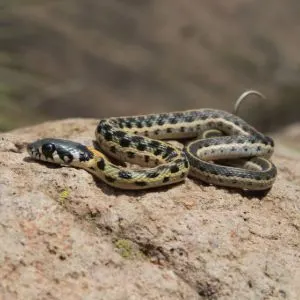
- Family: Colubridae
- Scientific Name: Thamnophis cyrtopsis cyrtopsis
- Other Names: Blackneck Garter Snake
- Adult Size: 20 to 42 inches (50 to 105 cm)
- Lifespan: 10 years
Western Black-necked Garter snakes are a subspecies of the Black-necked Garter snake that is found only in the western-most county in Oklahoma’s Panhandle region. This species can swim and hunts in rivers for its preferred prey of small fish.
Western Black-necked Garter snakes are a dark green color with vibrant orange to yellow bands running down their middle body.
They have a series of black patches near to their head which then leads into the striped section. Their undersides are cream or pale gray.
This species is semi-aquatic and swims in rivers, but can also be found on land close to water sources such as grasslands or forests.
8. Western Ribbon Snake
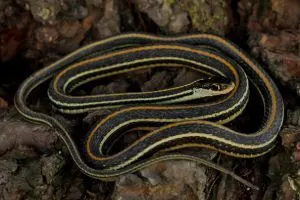
- Family: Colubridae
- Scientific Name: Thamnophis proximus proximus
- Other Names: Orange-stripe Ribbon snake
- Adult Size: 18 to 36 inches (45 to 90 cm)
- Lifespan: 4 to 5 years
Western Ribbon Snakes are a close relative of Garter snakes and can be found across most of Oklahoma apart from the extreme western Panhandle counties. These snakes like to remain close to rivers or streams while hidden in thick vegetation. Their tails take up about a third of their total body size.
Western Ribbon snakes are black or dark brown and have several vibrant orange stripes running down their bodies. Their undersides are yellowish to white.
Their scales feature prominent keels with a singular anal plate. The diet of Western Ribbon snakes consists mainly of amphibians and fish
9. Kansas Glossy Snake
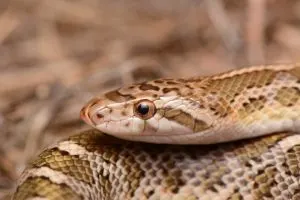
- Experience Level: Beginner
- Family: Colubridae
- Scientific Name: Arizona elegans elegans
- Other Names: Kansas Faded snake
- Adult Size: 26 to 36 inches (65 to 90 cm)
- Lifespan: 10 to 20 years
- Average Price Range: $40
Kansas Glossy snakes are the nominate subspecies of the Glossy snake. Also known as Faded snakes, these beautiful colubrids are found in Oklahoma’s western regions in open habitats such as deserts or dry grasslands.
Glossy snakes get their name from the shiny appearance of their smooth-scaled bodies. Kansas Glossy snakes are usually light brown with darker brown patches and patterning across their bodies. They have plain undersides and a singular anal plate.
Glossy snakes have calm temperaments, which make them good beginner snakes. Kansas Glossy snakes eat a diet of small mammals and other reptiles such as lizards. These snakes are largely nocturnal.
10. Bullsnake
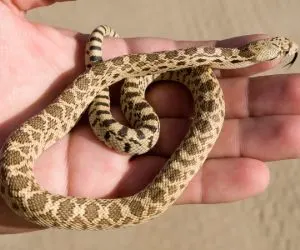
- Experience Level: Intermediate
- Family: Colubridae
- Scientific Name: Pituophis catenifer sayi
- Other Names: N/A
- Adult Size: 48 to 72 inches (120 to 180 cm)
- Lifespan: 10 to 30 years
- Average Price Range: $90 to $200
Bullsnakes are a large subspecies of the Gopher snake (Pituophis catenifer), growing somewhere between 4 feet and 6 feet long. Bullsnakes can make for impressive pet snakes, but they are constrictors so a degree of experience is necessary.
In Oklahoma, Bullsnakes can be found across much of the state except for extreme eastern counties. These large diurnal snakes inhabit a diverse range of areas including open grasslands as well as woodland surroundings.
They will consume birds, mammals, and smaller reptiles.
Bullsnakes have yellow to tan bodies and dark brown patterning. Their undersides are yellowish and are covered in dark brown spots as well.
This species is often mistaken for a Rattlesnake, but isn’t a threat to humans because they aren’t venomous. They will hiss and shake their tails against the ground when threatened.
11. Northern Rough Green Snake
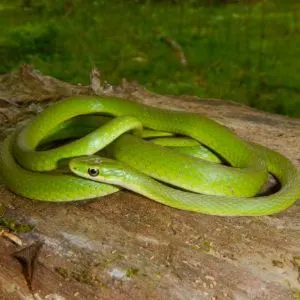
- Experience Level: Intermediate to Expert
- Family: Colubridae
- Scientific Name: Opheodrys aestivus aestivus
- Other Names: Grass snake, Green Grass snake
- Adult Size: 20 to 40 inches (50 to 100 cm)
- Lifespan: 6 to 8 years
- Average Price Range: $30
Northern Rough Green snakes are the nominal subspecies of the Rough Green snake. These arboreal serpents are excellent climbers and can be found in shrubs and trees across most of central and eastern Oklahoma. They aren’t found in western parts of the state.
Northern Rough Green snakes are fairly common and are a popular pet species. However, they can be jumpy and may go off feeding if uncomfortable, so they are recommended for experienced snake keepers.
This species predominantly eats insects.
These beautiful snakes are unsurprisingly green, with white or yellowish undersides. They have rough, keeled scales and a divided anal plate.
Once used to handling, Rough Green snakes can be pretty calm and docile.
12. Western Ground Snake
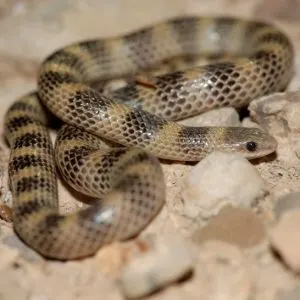
- Family: Colubridae
- Scientific Name: Sonora semiannualata semiannualata
- Other Names: Common Ground snake, Miter snake, Variable Ground snake
- Adult Size: 8 to 15 inches (20 to 40 cm)
- Lifespan: 4 to 5 years
Western Ground snakes are also known as Variable Ground snakes because of their incredibly diverse patterning and coloration.
They have light brown bodies and some variation of orange and dark brown patterning which can take the form of either bands, blotches, or stripes. They have smooth scales and shiny bodies.
In Oklahoma, Western Ground snakes have a diverse range, found across most of the state except for southeastern regions and the first counties of the Panhandle. These snakes like to burrow and prefer open areas with dry, loose substrates and can be found hiding under logs or rocks.
Western Ground snakes are nocturnal and will shy away from contact. They are mainly insectivores, eating centipedes, crickets, larvae, scorpions, and spiders.
13. Eastern Hog-nosed Snake
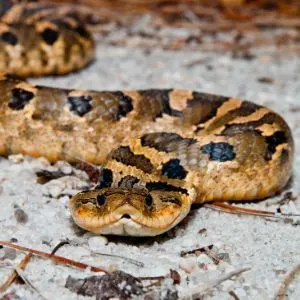
- Experience Level: Beginner
- Family: Colubridae
- Scientific Name: Heterodon platirhinos
- Other Names: Deaf Adder, Spreading Adder
- Adult Size: 20 to 40 inches (50 to 100 cm)
- Lifespan: 8 to 10 years
- Average Price Range: $120 to $200
Eastern Hog-nosed snakes are a characterful species that are commonly kept as pets. They are relatively docile and are not harmful to humans as their venom is incredibly mild.
These beloved colubrids are famous for their shovel-like beaks, which they use to headbutt attackers rather than bite.
In Oklahoma, Eastern Hog-nosed snakes are found throughout the state. They inhabit areas of grassland and woodland with sandy soils.
Their main prey in the wild are amphibians such as frogs. These prey animals are vulnerable to the Hog-nosed snake’s venom.
Eastern Hog-nosed snakes have light brown to yellowish-brown bodies with dark brown patterning.
Their upturned snouts are their most famous feature. They can be found in a variety of morphs as well, including some melanistic ones.
14. Plains Hog-nosed Snake

- Experience Level: Beginner
- Family: Colubridae
- Scientific Name: Heterodon nasicus
- Other Names: Prairie Hog-nosed snake, Western Hog-nosed snake
- Adult Size: 16 to 30 inches (40 to 75 cm)
- Lifespan: 8 to 10 years
- Average Price Range: $120 to $200
Plains Hog-nosed snakes, also known as Western Hog-nosed snakes, share the same beloved reputation as their Eastern cousins above. Their charming upturned snouts and relatively docile nature make them a good choice of pet snake, especially for beginners.
Plains Hog-nosed snakes live in regions with open grasslands and prairies with sandy soils. These snakes are found in central and western counties of Oklahoma.
They will hunt amphibians, birds, smaller reptiles, and rodents as their main prey.
Plains Hog-nosed snakes have brown or tan coloring and darker patches or patterns across their body. Their undersides are dark, which sets them apart from the Eastern Hog-nosed snakes.
15. Prairie Kingsnake
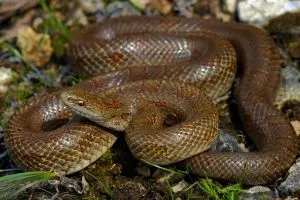
- Experience Level: Intermediate
- Family: Colubridae
- Scientific Name: Lampropeltis calligaster calligaster
- Other Names: Yellow-bellied Kingsnake
- Adult Size: 30 to 48 inches (75 to 120 cm)
- Lifespan: 15 to 25 years
- Average Price Range: $50 to $200
Prairie Kingsnakes are a large species found throughout most of Oklahoma aside from two of the Panhandle’s western-most counties. Unsurprisingly, these snakes are found on prairies and open grasslands, but can also inhabit farmland and abandoned buildings.
Prairie Kingsnakes have brown or tan coloration and sport a range of dark brown blotch and spot markings.
They have yellow undersides with black spots, which makes them easily confused for Rattlesnakes. However, Prairie Kingsnakes have a singular anal plate, while Rattlesnakes have a divided one.
These Kingsnakes can shake their tails when threatened, but will not often bite. They can musk though. These snakes eat smaller reptiles and rodents.
16. Speckled Kingsnake
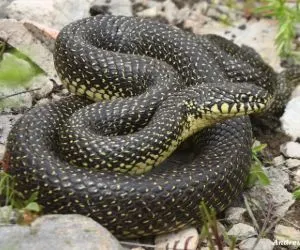
- Experience Level: Intermediate
- Family: Colubridae
- Scientific Name: Lampropeltis getula holbrooki
- Other Names: Salt and Pepper snake
- Adult Size: 36 to 48 inches (90 to 120 cm)
- Lifespan: 15 to 25 years
- Average Price Range: $100 to $250
Speckled Kingsnakes are a vibrant species with beautiful coloration.
This snake has black scales that also contain yellow spots, earning these Kingsnakes their name. They have singular anal plates to distinguish them from Rattlesnakes.
Speckled Kingsnakes are common across the whole of Oklahoma and can be found in farmland, prairies, and other open regions. This species is often kept as a pet but they are recommended for intermediate keepers as they are constrictors.
These beautiful serpents will hunt and eat birds, small mammals and rodents, and other smaller reptiles or snakes. If threatened, they will hiss and shake their tail like a Rattlesnake but are not venomous or harmful to humans.
17. Lined Snake
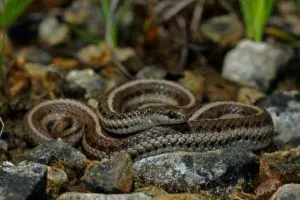
- Family: Colubridae
- Scientific Name: Tropidoclonion lineatum
- Other Names: Streaked snake, Striped snake
- Adult Size: 7 to 16 inches (18 to 40 cm)
- Lifespan: 3 to 10 years
Lined snakes are a relatively small species found in the central third of Oklahoma. They inhabit open prairies and less dense woodland regions but can also appear in urban surroundings because of their small size, their primary prey is earthworms.
Lined snakes will be various shades of gray with three noticeable stripes of a lighter color that stretch down their whole body. They have keeled scales and a singular anal plate.
Their undersides have crescent-shaped markings and are a pale color.
18. Western Long-nosed Snake
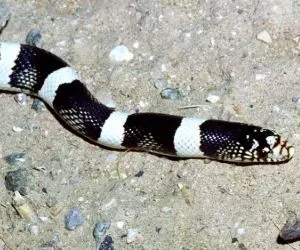
- Family: Colubridae
- Scientific Name: Rhinochelius lecontei
- Other Names: N/A
- Adult Size: 20 to 36 inches ((50 to 90 cm)
- Lifespan: 10 to 20 years
Long-nosed snakes are a vividly colored species found in Oklahoma’s Panhandle region as well as some southwestern counties. This nocturnal species prefers drier areas of prairie and scrubland where it can burrow into the ground and hunt for lizards or rodents.
Long-nosed snakes sport a combination of black, white, and red coloration, with banded patterns that resemble those of a Coral snake. These vibrant serpents are smooth-scaled and have yellowish to cream undersides. Long-nosed snakes are unlikely to bite but will musk if they feel in danger.
19. Central Plains Milk Snake
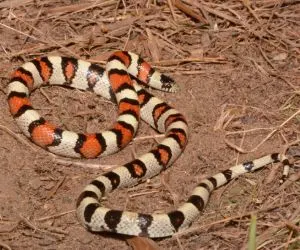
- Experience Level: Beginner
- Family: Colubridae
- Scientific Name: Lampropeltis triangulum
- Other Names: N/A
- Adult Size: 16 to 36 inches (40 to 90 cm)
- Lifespan: 15 to 20 years
- Average Price Range: $80 to $125
Three species of Milk Snakes are native to Oklahoma; the Central Plains Milk snake (Lampropeltis triangulum gentilis), Louisiana Milk snake (Lampropeltis triangulum amaura), and the Red Milk snake (Lampropeltis triangulum syspila).
These three types each inhabit different regions of Oklahoma and can be found in both open spaces such as prairies as well as woodland areas.
The Central Plains Milk snake is the most common and is found in central and western regions. The Louisiana Milk snake is confined to extreme southeastern counties, while the Red Milk snake inhabits the eastern half of Oklahoma.
Milk snakes are one of the easiest pet snakes and are often recommended for beginners due to their manageable size and thin bodies. They are an active and beautifully colored nocturnal species.
Oklahoma’s Milk snakes are predominantly red in color, with black and white bands on their smooth-scaled bodies. Milk snakes prey on rodents and smaller reptiles.
20. Western Mud Snake
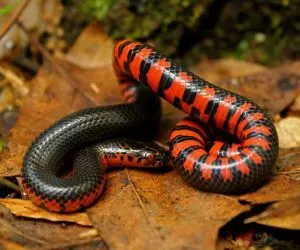
- Family: Colubridae
- Scientific Name: Farancia abacura reinwardtii
- Other Names: Hoop snake
- Adult Size: 38 to 60 inches (95 to 150 cm)
- Lifespan: Unknown
Western Mud snakes are a fully aquatic species that very rarely venture out of the water. These large snakes are confined to the southern half of Oklahoma’s McCurtain county.
They need marshy regions or swamps, where they can stay underwater and hunt their amphibian prey.
Western Mud snakes are smooth-scaled snakes with shiny black bodies with reddish or pink bands on their undersides. They have divided anal plates.
Western Mud snakes are rarely aggressive, resorting to poking assailants with their harmless spiked tails.
21. Texas Night Snake
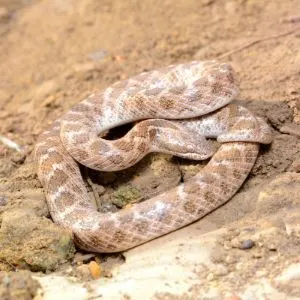
- Family: Colubridae
- Scientific Name: Hypsiglena jani texana
- Other Names: Chihuahuan Night snake
- Adult Size: 12 to 16 inches (30 to 40 cm)
- Lifespan: 10 to 12 years
Texas Night snakes are a nocturnal species found in scattered areas of Oklahoma.
They are most prevalent in the southwestern counties, but can also be found in parts of the northwest as well. During the day, these snakes shelter under logs or rocks and inhabit drier areas with sandy ground.
Texas Night snakes have drab brown smooth-scaled bodies with dark brown patterning. Their undersides are white and they also have markings on their necks.
Behind their eyes, these snakes also have brown bars.
These rear-fanged snakes are mildly venomous but pose no threat to humans. Their prey consists of amphibians and small lizards who will succumb to the Night snake’s venom.
22. Eastern Yellow-bellied Racer
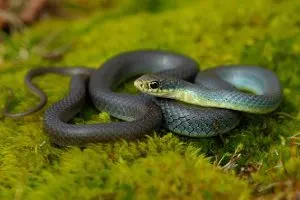
- Family: Colubridae
- Scientific Name: Coluber constrictor flaviventris
- Other Names: N/A
- Adult Size: 34 to 60 inches (85 to 150 cm)
- Lifespan: 10 years
One of two types of Racers found in Oklahoma, Eastern Yellow-bellied Racers are thin, fast-moving snakes found across much of the state except for extreme southeastern counties.
They occupy a range of habitats, from open grasslands to dense forests. Although their scientific name suggests that this species constricts its prey, this isn’t actually the case.
Eastern Yellow-bellied Racers are predominantly brown or olive green and have no markings. Their undersides are yellow, which gives them their name.
These diurnal species prey on amphibians, birds, insects, reptiles, and rodents. They will bite if they feel threatened but are not venomous.
23. Southern Black Racer
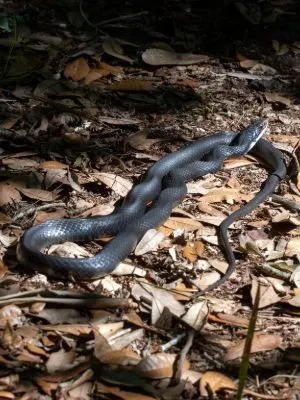
- Family: Colubridae
- Scientific Name: Coluber constrictor priapus
- Other Names: N/A
- Adult Size: 34 to 60 inches (85 to 150 cm)
- Lifespan: 10 years
Southern Black Racers are the other type of Racer snake native to Oklahoma. These active snakes are found mainly in eastern and southeastern counties of the state in a wide variety of habitats.
They can even be encountered in urban areas and will bite or musk to avoid capture. They are non-venomous.
These fast snakes have jet black skin with pale gray or white underbellies. Like other Racer snakes, Southern Black Racers are not actually constrictors.
Instead, they catch and then crush their prey. These diurnal snakes typically eat amphibians, rodents, and small lizards.
24. Great Plains Rat Snake
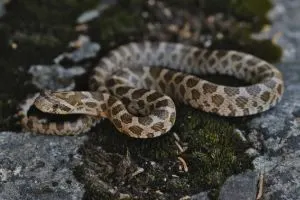
- Experience Level: Intermediate
- Family: Colubridae
- Scientific Name: Pantherophis emoryi
- Other Names: Brown Rat snake, Emory’s snake, Western Pilot snake
- Adult Size: 24 to 36 inches (60 to 90 cm)
- Lifespan: 10 to 15 years
- Average Price Range: $80
Great Plains Rat snakes can be interesting pet specimens for intermediate keepers. Their care requirements are relatively simple, but Rat snakes can have some challenging behavior.
If threatened, they will react similarly to a Rattlesnake unless they are used to handling.
Great Plains Rat snakes can be found throughout Oklahoma except for extreme southeastern counties. They usually inhabit lightly wooded areas or stretches of open grasslands. They are nocturnal hunters who mainly eat rodent prey.
Great Plains Rat snakes have light brown bodies with dark patch markings across their skin. Their underbellies have checkered patterning and there are stripes underneath their tails.
To differentiate these snakes from Prairie Kingsnakes, the Great Plains Rat snake has a divided anal plate.
25. Western Rat Snake
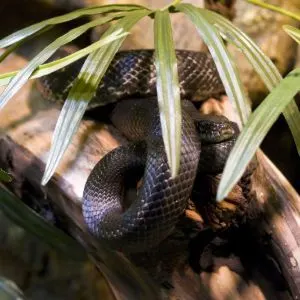
- Experience Level: Beginner to Intermediate
- Family: Colubridae
- Scientific Name: Pantherophis obsoletus
- Other Names: Black Rat snake, pilot black snake, and black snake
- Adult Size: 34 to 72 inches (85 to 180 cm)
- Lifespan: 10 to 15 years
- Average Price Range: $60 to $100
Western Rat snakes, also known as Black Rat snakes due to their dark coloration, can be found across most of Oklahoma apart from the western Panhandle counties. These impressive snakes are popular as pets, with relatively simple care requirements and agreeable temperaments for the most part.
Western Rat snakes have dark brown to black skin and may sometimes have orange or red fleck markings. Their underbellies range from cream to yellowish-green, occasionally with mottled markings.
These snakes usually inhabit open farmland or lightly wooded regions.
They can sometimes be encountered in trees or on the roofs of buildings as they search for birds and their eggs. Western Rat snakes will also eat rodents.
26. Northern Red-bellied Snake
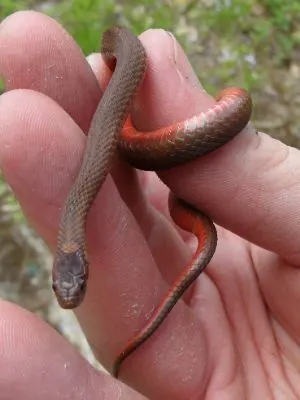
- Family: Colubridae
- Scientific Name: Storeria occipitomaculata occipitomaculata
- Other Names: Fire snake, Northern Redbelly snake
- Adult Size: 8 to 14 inches (20 to 35 cm)
- Lifespan: 4 years
Northern Red-bellied snakes are a small type of colubrid found in a few eastern counties of Oklahoma. These snakes are a subspecies of the Red-bellied snake (Storeria occipitomaculata) and can be encountered in gardens and woodlands with medium humidity.
Northern Red-bellied snakes have gray to red bodies. Markings can vary from broad bright colored stripes or four smaller darker stripes running down their bodies.
They have a collar of markings on their necks in the form of three lightly colored dots. They have orange or red undersides.
These beautiful small snakes can bury themselves while hunting their preferred prey of mollusks such as earthworms and slugs.
27. Mississippi Ring-necked Snake

- Family: Colubridae
- Scientific Name: Diadophis punctatus stictogenys
- Other Names: Mississippi Ringneck snake
- Adult Size: 10 to 17.5 inches (25 to 45 cm)
- Lifespan: 6 to 10 years
Mississippi Ring-necked snakes are a subspecies of the Ring-necked snake (Diadophis punctatus) that is found only in the southern part of Oklahoma’s McCurtain County near the Texas border. This small nocturnal species inhabits regions of pine forest and usually eats insects.
Mississippi Ring-necked snakes have black heads and dark gray bodies with a yellowish ring around their necks.
They have yellow undersides that become a dark orange underneath their tails. These snakes have speckled black dots on their undersides.
28. Prairie Ring-necked Snake
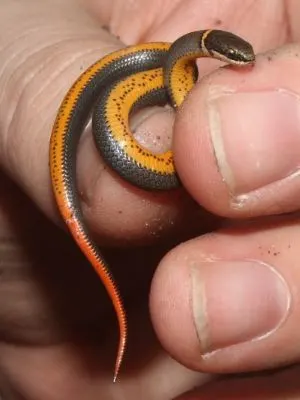
- Family: Colubridae
- Scientific Name: Diadophis punctatus arnyi
- Other Names: Prairie Ringneck snake
- Adult Size: 10 to 14 inches (25 to 35 cm)
- Lifespan: 6 to 10 years
Prairie Ring-necked snakes are the second Ring-necked snake subspecies found in Oklahoma. They are common across much of the state except for the southern parts of McCurtain county.
A rarely-seen nocturnal species, Prairie Ring-necked snakes inhabit prairies and grasslands as well as woodland areas.
Prairie Ring-necked snakes have grayish-black heads and gray skin with an orange neck ring. Their underbellies gradually change from yellow to orange to red with irregular black speckles.
These small snakes prey on amphibians, insects, and baby rodents.
These snakes have mild venom which is harmless to humans but will incapacitate prey. Prairie Ring-necked snakes are constrictors.
29. Scarlet Snake
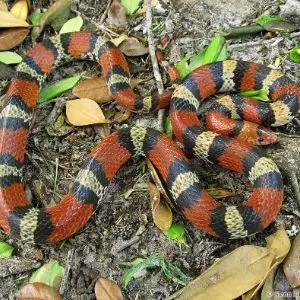
- Family: Colubridae
- Scientific Name: Cemophora coccinea
- Other Names: N/A
- Adult Size: 14 to 24 inches (35 to 60 cm)
- Lifespan: 5 to 10 years
Scarlet snakes are a species of nocturnal colubrid that is found in central and eastern regions of Oklahoma. This species hide under logs or rocks during the day in pine forests with loose, sandy substrates.
Scarlet snakes emerge only in the summer and hibernate for the rest of the year. They prey on smaller reptiles and their eggs as well as small mammals.
Scarlet snakes have pale or white bodies with red faces and thick red bands across their smooth-scaled skin. These bands have black surroundings.
Their undersides are pale white or yellow and they have a singular anal plate.
30. Flat-headed Snake
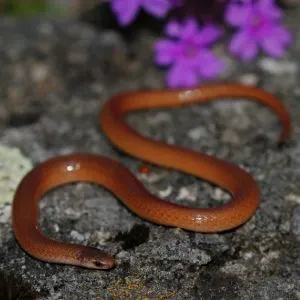
- Family: Colubridae
- Scientific Name: Tantilla gracilis
- Other Names: Flathead snake
- Adult Size: 7 to 8 inches (18 to 20 cm)
- Lifespan: 4 years
One of the tiny Tantilla genus species, Flat-headed snakes can sometimes be mistaken for large earthworms. They are often found in rocky areas and hillsides with woodlands throughout central and eastern Oklahoma. They are nocturnal and will remain buried beneath rocks or leaf litter during the day.
Flat-headed snakes range from dark brown to a rusty red color. Their flat heads are a darker shade than the rest of the body.
Their undersides are a pinkish color and they have smooth scales. Flat-headed snakes prey on insects and mollusks such as slugs and worms.
31. Plains Black-headed Snake
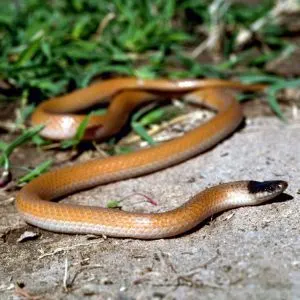
- Family: Colubridae
- Scientific Name: Tantilla nigriceps
- Other Names: Plains Blackhead snake
- Adult Size: 7 to 12 inches (18 to 30 cm)
- Lifespan: 4 years
Plains Black-headed snakes are another small Tantilla species found in Oklahoma. They inhabit western counties including the Panhandle and prefer grassy or rocky regions with moist substrates.
This rear-fanged snake is mildly venomous to its preferred prey of insects but is harmless to humans.
Plains Black-headed snakes are brown or reddish in color with distinctive black heads. Their undersides are pale with a central pinkish line.
This is a smooth-scaled species with a divided anal plate. These snakes are nocturnal and hide away under logs or rocks during the day.
32. Banded Water Snake

- Experience Level: Intermediate
- Family: Colubridae
- Scientific Name: Nerodia fasciata
- Other Names: Broad-banded Water snake, Southern Water snake
- Adult Size: 20 to 60 inches (50 to 150 cm)
- Lifespan: 9 to 10 years
- Average Price Range: $20 to $40
Banded Water snakes are a semi-aquatic species that is sometimes kept as a pet. They have relatively simple care requirements, but because their enclosure requires an aquatic section this can be challenging for beginners.
These snakes can also reach up to four feet in length.
Banded Water snakes are found in the extreme southeastern counties of Oklahoma close to the Texas border. They like to live near permanent water sources and can often be seen basking.
This species preys mainly on amphibians and fish.
Banded Water snakes are predominantly brown with orange or yellow markings. Their undersides are yellow with dark mottled patterning and have rough-keeled scales.
33. Common Water Snake
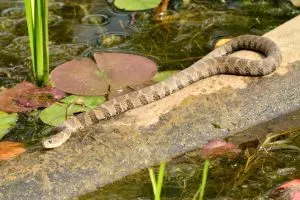
- Experience Level: Intermediate
- Family: Colubridae
- Scientific Name: Nerodia sipedon
- Other Names: Brown Water snake, Northern Water snake
- Adult Size: 20 to 42 inches (50 to 105 cm)
- Lifespan: 9 to 10 years
- Average Price Range: $20 to $40
Common Water snakes are widespread across much of the central and eastern United States. In Oklahoma, these semi-aquatic snakes can be found in eastern counties around state borders.
They can sometimes be mistaken for Cottonmouths, but are non-venomous and harmless to humans.
These snakes can be good pets for intermediate keepers, although most specimens are likely to be wild-caught. Common Water snakes are light brown to black, with darker bands on their bodies. Their underbellies range from white to gray or even yellow, with dark red crescent markings.
Common Water snakes can be distinguished from Cottonmouths by their flatter heads and thinner bodies.
These snakes mainly eat amphibians and fish and are found near permanent bodies of water. They can often be spotted basking.
34. Diamond-backed Water Snake
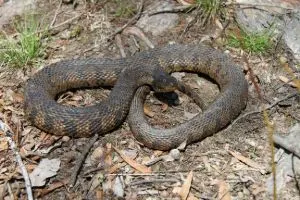
- Experience Level: Intermediate
- Family: Colubridae
- Scientific Name: Nerodia rhombifer
- Other Names: Diamondback Water snake
- Adult Size: 30 to 48 inches (75 to 120 cm)
- Lifespan: 9 to 10 years
- Average Price Range: $20 to $40
Diamond-backed Water snakes are a semi-aquatic species found near slower-moving water sources such as marshes and swamps. They are found throughout the whole of Oklahoma apart from the Panhandle.
They can make interesting captive pets for intermediate snake keepers.
Diamond-backed Water snakes range from green to brown, with diamond-shaped markings across their bodies and dark bands down their sides.
Their underbellies are yellowish with more dark patterns. This species has rough scales with prominent keels.
When foraging for their preferred prey of amphibians and fish, Diamond-backed Water snakes will hang from branches above the water and “fish” with their heads under the water. They can sometimes be confused with Cottonmouths but is usually not aggressive unless cornered.
35. Graham’s Water Snake
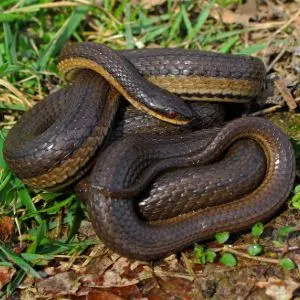
- Family: Colubridae
- Scientific Name: Regina grahamii
- Other Names: Graham’s Crayfish snake, Graham’s Leather snake, Graham’s Queen snake
- Adult Size: 18 to 30 inches (45 to 75 cm)
- Lifespan: 9 to 10 years
Graham’s Water snake, named after topographical engineer James Duncan Graham, is a semi-aquatic snake found across central Oklahoma. This species prefers slower-moving waters such as marshes and swamps.
Graham’s Water snakes make difficult captives, so are rarely seen as pets.
These snakes have brown or dark green bodies with yellowish sides and underbellies. Some specimens also have faint black lines dividing the two sections.
This species mainly eats crayfish, earning its nickname of Graham’s Crayfish snake. They may also eat amphibians or mollusks.
36. Plain-bellied Water Snake
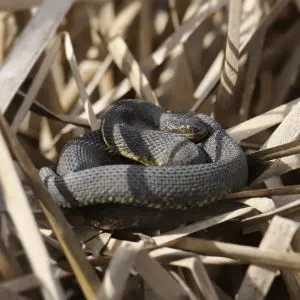
- Experience Level: Intermediate
- Family: Colubridae
- Scientific Name: Nerodia erythrogaster
- Other Names: Plainbelly Water snake
- Adult Size: 30 to 48 inches (75 to 120 cm)
- Lifespan: 9 to 10 years
- Average Price Range: $20 to $40
Plain-bellied Water snakes are a semi-aquatic species that spends more time on land than other Water snakes. Its instinctive escape route will actually be across the land, rather than through the water. In hotter, humid conditions this species moves away from water.
Plain-bellied Water snakes have brown to gray bodies with yellowish sides and underbellies. This snake is relatively plain, with dark brown markings at the edges of its underside scales.
This species is found throughout the whole of Oklahoma near permanent sources of water. Their main prey include amphibians and fish.
37. Coachwhip Snake

- Family: Colubridae
- Scientific Name: Masticophis flagellum
- Other Names: Whip snake
- Adult Size: 36 to 82 inches (90 to 200 cm)
- Lifespan: 8 to 10 years
There are two subspecies of Coachwhips found in Oklahoma; the Eastern Coachwhip (Masticophis flagellum flagellum) and the Western Coachwhip (Masticophis flagellum testaceus). These narrow snakes are extremely fast, but are also one of the longest snakes encountered in Oklahoma.
Eastern Coachwhips are dark brown or black in color, with their coloration gradually shifting to a reddish shade further down their bodies. Western Coachwhips are a singular color, usually dark to light brown.
Both types are smooth-scaled and are found in dry prairies or hilly areas.
Coachwhips are active diurnal snakes, feeding on insects, lizards, and rodents. They hunt by trapping their prey in the powerful jaws and holding on.
These snakes will often flee from potential threats but can bite if cornered. They are non-venomous.
38. Western Worm Snake
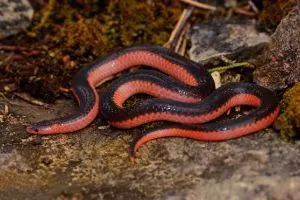
- Family: Colubridae
- Scientific Name: Carphophis vermis
- Other Names: N/A
- Adult Size: 8 to 11 inches (20 to 30 cm)
- Lifespan: 4 to 5 years
Western Worm snakes are a small fossorial species found in Oklahoma’s eastern counties. They bury themselves in moist substrates such as leaf litter in rocky or wooded areas. Here, they hunt for earthworms and occasionally smaller insects.
Western Worm snakes have black to purple upper smooth-scaled skin with vibrant red, orange, or pink sides and underbellies. They are relatively round in terms of body shape, with short tapered tails.
If threatened, these snakes will release a cloud of musk to deter predators.
Venomous Snakes in Oklahoma
Those were Oklahoma’s 38 harmless snake species, but our next few specimens are deadly venomous snakes that should be avoided if at all possible:
39. Copperhead Vipers
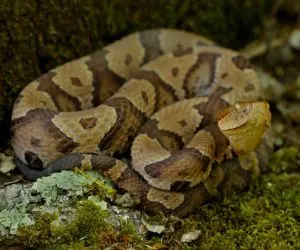
- Family: Viperidae
- Scientific Name: Agkistrodon contortrix
- Other Names: Eastern Copperhead, Highland Moccasin
- Adult Size: 22 to 36 inches (55 to 90 cm)
- Lifespan: 15 to 18 years
Copperheads are a species of pit viper found in Oklahoma’s central and eastern areas.
These serpents are venomous but aren’t deadly to humans. Getting bitten is likely to cause painful swelling and nausea.
Copperheads are found mainly in woodland areas where they can camouflage themselves among leaf litter. There are two subspecies found in Oklahoma; Eastern Copperheads (Agkistrodon contortrix) and Broad-banded Copperheads (Agkistrodon laticinctus). Both species look very similar.
Copperheads have orange to tan bodies with darker band markings of red to brown. Their skin is rough, with slightly keeled scales and a heat-sensing gland between their vertical eyes and their nose.
These vipers will hide under logs or in leaf litter and freeze, making them practically invisible. They mainly prey on small mammals but will also eat amphibians, insects, and lizards.
40. Northern Cottonmouth
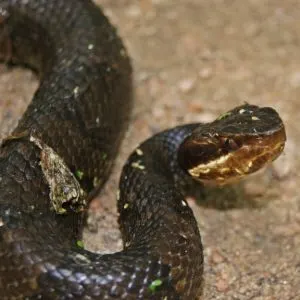
- Family: Viperidae
- Scientific Name: Agkistrodon piscivorus leucostoma
- Other Names: Cottonmouth, Water Moccasin, Water Viper
- Adult Size: 20 to 42 inches (50 to 105 cm)
- Lifespan: 10 years
Cottonmouths are muscular pit vipers that carry an extremely painful bite.
These snakes are fairly aggressive and their venom can leave victims with scars or even require amputation in extreme incidents. This species is semi-aquatic and occurs in the extreme eastern, southern, and southwestern parts of Oklahoma.
Cottonmouths get their name from the pale white insides of their mouths, which they hold open while coiling up if they feel threatened.
They are dark in color, ranging from black to brown or dark green. Their underbellies are pale cream with mottled patterns. They have heat-sensing glands beneath their vertical pupils.
Cottonmouths inhabit forested areas around slower-moving bodies of water such as swamps. They prey on amphibians, birds, fish, and smaller reptiles.
They have even been known to catch small alligators. They will often corner their prey in the water, where they are also capable of biting.
41. Prairie Rattlesnake
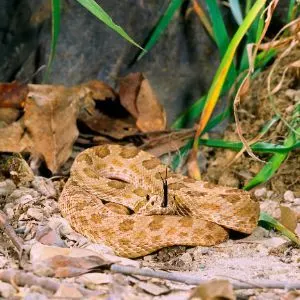
- Family: Viperidae
- Scientific Name: Crotalus viridis
- Other Names: Great Plains Rattlesnake, Western Rattlesnake
- Adult Size: 32 to 46 inches (80 to 120 cm)
- Lifespan: 10 to 25 years
Prairie rattlesnakes are some of the most widespread venomous snakes in the United States, found throughout much of the Great Plains region. In Oklahoma, these medium-sized vipers are found in extreme western counties and the Panhandle region.
Prairie rattlesnakes are highly venomous and can deliver a large amount of venom in some bites. Fatalities do occur, but they are exceptionally rare among humans.
When threatened, these snakes will rise up and rattle their tails violently, making a shaking sound.
These vipers have tan or light brown bodies with dark brown markings across their bodies. Their underbellies are a plain gray or pale color.
Gray stripes ring their tails close to the rattles. Beneath their vertical pupils, Prairie rattlesnakes have heating pits.
Prairie rattlesnakes prefer grasslands and prairies, where they prey on small mammals, including prairie dogs. They will also eat birds and reptiles.
42. Timber Rattlesnake

- Family: Viperidae
- Scientific Name: Crotalus horridus
- Other Names: Banded rattlesnake, Canebrake rattlesnake, Velvet Tail
- Adult Size: 35 to 55 inches (90 to 140 cm)
- Lifespan: 20 to 25 years
Timber rattlesnakes are a deadly species of viper found in eastern parts of Oklahoma, except northeastern counties.
The bite of a Timber rattlesnake is fatal to a human, and if bitten you should get to the hospital immediately. Thankfully, these rattlesnakes don’t bite often and will shake their tails for a while before striking.
Timber rattlesnakes inhabit woodland regions with rocky parts. This species has a long brumation period, which also helps to cut down on bite incidents. Timber rattlesnakes mainly prey on small mammals, but will also eat amphibians, birds, and smaller reptiles such as Garter snakes.
These deadly vipers have brown coloration, starting with golden-brown towards their heads and getting darker down the body. Their tails are almost black.
They have dark band markings often ringed with orange. Timber rattlesnakes have obvious heat-sensing pits underneath their vertical eyes.
43. Western Diamondback Rattlesnake

- Family: Viperidae
- Scientific Name: Crotalus atrox
- Other Names: Coon-tailed Rattler, Texas Diamond-back
- Adult Size: 32 to 82 inches (80 to 210 cm)
- Lifespan: 20 to 25 years
Western Diamondback rattlesnakes are one of the largest species and can reach up to six feet in length.
These powerful snakes have enough venom to kill a human being in extreme cases. They are also quite aggressive if threatened, shaking their tails violently before striking.
Western Diamondbacks are found scattered across Oklahoma, including central-eastern areas, extreme southwestern counties, and a few scattered populations in between. These large snakes prefer dry grassland or rocky areas such as canyons.
Western Diamondbacks have light brown skin with dark diamond-shaped patterns. Their undersides are pale gray or white.
Towards the ends of their tail, they have horizontal black and white markings just before their rattles. They have vertical eyes above heat-sensing pits.
The prey for these large vipers is mainly small mammals, which are incredibly susceptible to the venom of these rattlesnakes. They may also eat birds or lizards.
44. Western Massasauga Rattlesnake
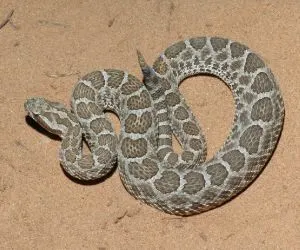
- Family: Viperidae
- Scientific Name: Sistrurus catenatus tergeminus
- Other Names: Buzztails, Ground rattlesnake, Gulf Coast massasauga
- Adult Size: 18 to 30 inches (45 to 75 cm)
- Lifespan: 10 to 25 years
Western massasauga rattlesnakes are a subspecies of the massasauga and are found in western parts of Oklahoma except for the Panhandle region. This species has potent venom which can be lethal if untreated.
However, this rattlesnake generally uses smaller doses in its bites, which can still cause severe pain and swelling.
Western massasaugas are light brown with dark brown patterning across their bodies, including thick stripes over their vertical eyes. These snakes have rough, keeled scales and clearly identified heat-sensing glands.
This species of massasauga inhabits grassland prairies and rocky areas as well as marshes. They prey on small mammals but will also hunt amphibians and reptiles. They have a higher-pitched rattle than many other rattlesnakes.
45. Western Pygmy Rattlesnake
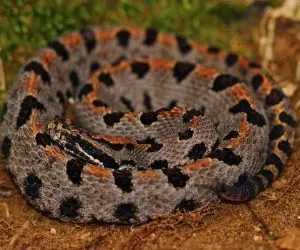
- Family: Viperidae
- Scientific Name: Sistrurus miliarius streckeri
- Other Names: Ground Rattler, Strecker’s Pygmy rattlesnake
- Adult Size: 15 to 25 inches (38 to 60 cm)
- Lifespan: 10 to 25 years
Western Pygmy rattlesnakes are a subspecies of the Pygmy rattlesnake and are named after John Kern Strecker, a 19th Century American naturalist. This smaller species isn’t fatal to humans, but their bite is still painful and unpleasant.
The rattle of this species is relatively quiet and can only be heard at close range. Aggressiveness varies depending on the individual snake.
Western Pygmy rattlesnakes have gray bodies with dark brown patch markings ringed with orange across their keeled scales. They also have reddish stripes running down their backs.
Western Pygmy rattlesnakes have heat-sensing pits below their vertically slitted eyes.
These rattlesnakes are only found in southeastern regions of Oklahoma and inhabit pine forests with slower-moving sources of water such as marshes or ponds. They prey on small rodents or mammals and will sometimes eat small reptiles as well.
Frequently Asked Questions
How can you identify venomous snakes in Oklahoma?
Given similar appearances shared by non-venomous and venomous species in Oklahoma, it can sometimes be difficult to identify dangerous snakes. However, one of the easiest ways to identify a venomous snake is to look for a heat-sensing pit.
All of Oklahoma’s venomous snakes belong to the pit viper family. These vipers have special organs between their nostrils and eyes that allow them to see body heat, even at night. Look for an extra nostril-looking hole on the snake’s snout to identify a venomous species.
Venomous snakes also have triangular or wedge-shaped heads, as opposed to more rounded or flatter heads for non-venomous species.
How common are snake attacks in Oklahoma?
Despite a wide range of snakes native to Oklahoma, snake attacks are thankfully quite rare in the state. There are only 7 venomous species in Oklahoma, which should be avoided if at all possible. In 2018, only 300 snake bites were reported across Oklahoma.
Can you kill rattlesnakes in Oklahoma?
Rattlesnakes can be killed by anyone in Oklahoma if the snake is deemed to be a nuisance or a threat. However, when it comes to specific rattlesnake hunting in the wild, it is only legal if you have a fishing or hunting permit or license.
The hunting season runs from March to the end of June. Some limits are in place regarding the quantity of certain species.
What is the most venomous snake in Oklahoma?
There are seven species of venomous snake in Oklahoma, but not all of these have venom potent enough to kill a human. Of these snakes, Timber rattlesnakes and Western Diamondback rattlesnakes are likely to be the most deadly due to their higher doses of venom and large fangs.
Death is not a certainty in all incidents with these two snakes, as long as the bite is treated quickly. But the fatal danger is still present. Avoid these species if at all possible.
Conclusion
And that wraps up our list of snakes in Oklahoma! We’ve covered 45 snakes in this list, with 38 harmless species and 7 venomous snakes. Some of the harmless species are regularly kept as pets, such as Hog-nosed snakes, so check out the relevant care guides for more information.
Whether you use this list as a field herping guide or an overview of a species you want to keep as a pet, we hope you enjoyed it! If so, please don’t hesitate to comment down below.
Snakes in Other States:

Veronica
Saturday 15th of October 2022
Hey Y'all! just a quick question I found a snake (have a few pictures) where can I submit these for identification?
Snaketracks
Friday 21st of October 2022
Send us an email at [email protected] with the pics :)
Carl
Friday 20th of May 2022
Identity of a approx 48"black snake with red on sides,not sure about the belly. Shakes tail when threatened and strikes at you. Thnx
Peyton
Tuesday 20th of July 2021
Photo for the Timber Rattlesnake is actually a Russell’s Pit Viper
Snaketracks
Tuesday 20th of July 2021
Thanks for pointing that out! I got it swapped out and updated in our database.